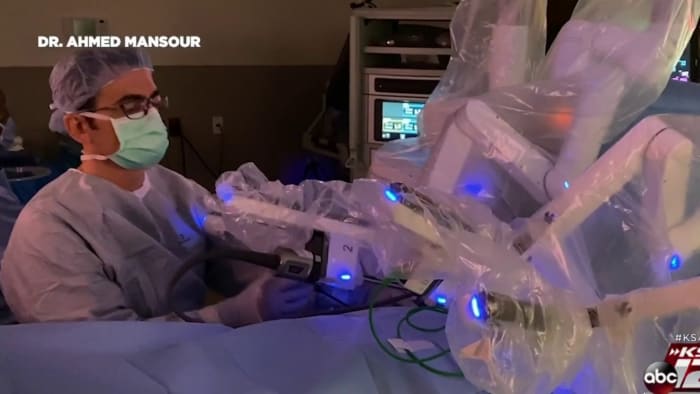SAN ANTONIO – – Testicular cancer is most common in younger men, ages 15-30 years old.
In more complicated cases where the disease has spread, the only option used to be a serious open surgery, but a robot is now changing that, getting these young patients back on their feet faster.
Antonio Flores is only 21 and in his prime, so it was a shock in February when he found out he had testicular cancer.
“They told me, ‘Yeah we have to remove the testicle.’ I was like, ‘Okay, go ahead.’ I’d rather lose a testicle than my life,” he said.
However, that was just the beginning. He then went through weeks of chemotherapy only to find out he was one of the rare patients whose lymph nodes in the back of his abdomen were still infected.
“It’s quite complex and quite rare because these lymph nodes are right next to the major vessels,” said Dr. Ahmed Mansour, associate professor of urology at UT Health San Antonio and a surgeon with Mays Cancer Center, home to UT Health San Antonio MD Anderson Cancer Center.
Ad
Dr. Mansour said typically the only procedure available is a complicated open surgery, which is only available at a few centers in the nation and takes months of recovery.
“The traditional surgery involves a large incision, which extends from the chest bone all the way across the abdomen,” he said.
Mansour hated seeing young patients held back from their lives for so long as they recovered, so he helped utilize a massive surgical robot to more effectively remove these lymph nodes in patients like Flores.
The surgeon sits in the corner of the operating room controlling instruments attached to long robot arms, inserted through small incisions in the patient’s belly.
“The advantages are less blood loss, faster recovery, and less pain after the surgery,” Mansour said.
The Mays Cancer Center took the robotic procedure done only a few times around the nation, and modified the technique further.
“This procedure has been done in the past but only for patients who did not get chemotherapy, because chemotherapy makes these masses stuck to the vessels and it becomes quite hard for them to be taken out. In the past, it was also performed to take the lymph nodes from only one side of the belly,” Mansour said.
Ad
The robotic surgery allows surgeons like Mansour to operate on both sides of the abdomen on testicular cancer patients like Flores who have had chemo.
In May, Flores was the first patient to undergo that procedure here in San Antonio, and became one of just a handful of patients across the country.
Since Flores’ surgery, Mansour has done the procedure once more.
“He got amazed at how fast I’ve been recovering. Since the surgery, I would say three weeks… not even,” Flores said.
He’s back to working as an auto mechanic and is proud to be cancer-free.
“The fastest I can get recovered to get back to work the better because honestly I got a lot of bills to pay,” Flores said.
That’s the very reason Mansour and his colleagues are continuing their quest to perfect the robotic procedure until it’s used more regularly nationwide.
UT Health San Antonio is now promoting the new technique to other centers and creating a multi-center study evaluating this approach to the traditional open surgery.
Ad
While Mansour works on that, he also is promoting prevention, saying the best way to keep patients safe is through self-examination.
“Usually testicular cancer comes without any symptoms, but they feel a mass or a lump on their testes. Usually discovered during showering or self-examination,” he said.
He urges men to do regular self exams and go to the doctor if they believe they feel something abnormal.
Copyright 2021 by KSAT – All rights reserved.
Credit: Source link





















